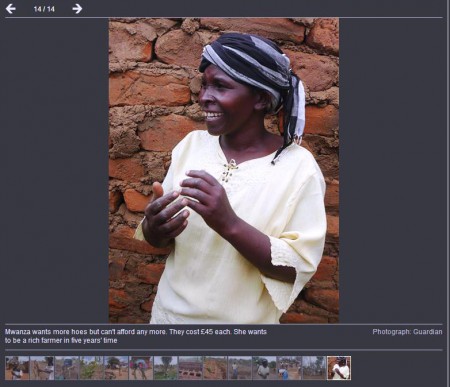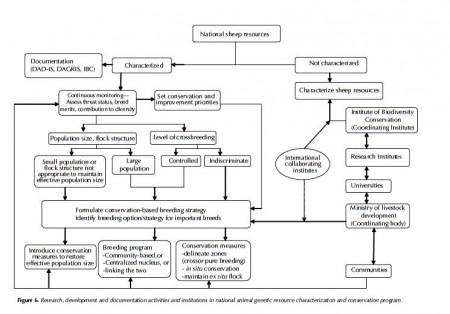- Do polycultures have a role in modern agriculture? Well, do they? h/t The Scientist Gardener.
- Texas breeders go for better melons.
- “Children from the city who try this yogurt don’t like it, but they’re not healthy like my children!”
- Hotspots for Aboriginal traditional medicinal plants mapped to within an inch of their lives, thanks to GBIF.
The price of hoes in Kenya
This post is not really about agricultural biodiversity, but I think it is worth stretching a point on some occasions. Take a look at the caption for this photograph. It’s the last in a gallery from The Guardian which goes with a nice write-up of what sounds like a very worthy Farm Africa project.
Forty-five pounds for a hoe? Forty-five pounds? I must say I’d missed that when I first went through the photos, but when Jeremy pointed it out I had to admit that seemed a bit steep for a hoe.
Well, is it just us? What do we know about the price of hoes in Kenya, right? Internal evidence in the article suggests that £45 is a lot of money, but a fair price for a hoe.
But low-tech can still be costly. Mwanza says she would like more hoes, but at £45 a hoe, it is far more than she can afford. The simple brick house she lives in with one of her children is no bigger than a small bedroom.
But googling comes up with a much cheaper price in Uganda:
“A hoe is a very cheap thing. It costs Shs 7,500 each and when I buy one it can last more than two years,” Nyakoojo said.
That would be about £1.70. And when the wife sent text messages to everyone she could think of in Kenya she got back figures closer to the Ugandan than The Guardian. A very fancy hoe goes for about KSh 1,200, or £8, we were told.
So what’s going on? Normally, I’d probably just dismiss it as a misplaced decimal point somewhere. Or perhaps a misunderstanding about what exactly the tool involved is. But it appears that this “hoe” is the weapon of choice in the Manichean fight against GMOs.
Small African farmers such as Mwanza stand on the frontline in the battle for higher productivity and agricultural development, a struggle being fought not with tractors and GM crops but with hoes, wheelbarrows and indigenous drought-resistant crops: cowpeas, pigeon peas, green grams, sorghum and millet.
So I think we should all be extra clear about what one costs. Starting with The Guardian. And the Gates Foundation.
Nibbles: Nigerian farmer speaks, Kenya meeting, Ecuador, Striga-resistant sorghum, Designer veg, Cottontail, Funding conservation, African adaptation
- Why one Nigerian agriculture student will not become a farmer.
- Meeting in Kenya on agricultural biodiversity, and other stuff, in October.
- Ecuador and access to genetic resources (in Spanish).
- “Scientists on the verge of releasing new striga-resistant sorghum.” Drought-resistant too! No need for push-pull then?
- One wacky plant breeder’s story.
- Attractive local bunny in trouble. Not what you’re thinking, get your mind out of the gutter.
- Forest bonds in the offing. Genebank bonds, anyone?
- Climate change adaptation in Africa: examples of genetic and agronomic fixes. Need both, I guess.
From sheep to crops
ILRI’s research report “Characterization and conservation of indigenous sheep genetic resources: A practical framework for developing countries” has a nifty flow diagram at the back which sort of summarizes what you have to do as a national programme to conserve your indigenous sheep breeds. I don’t think it would need to be tremendously dissimilar to be applicable to crop landraces. Any thoughts?
Nibbles: G20, Organics, Oca, Cassava, Molecular phylogenetics, Human diversity, OFSP
- G20 nations turn to agricultural research for food security. All you need to know.
- Would it be worth updating Borlaug on organics? A Prinz says “Yes!”
- Rhizowen gets oca to grow seed to seed. Can Cornish “potatoes” be far behind?
- Is it cassava‘s time?
- Molecular taxonomy helps an allergy sufferer.
- Lagging behind in development? Maybe you’re too diverse. Or not diverse enough. Difficult, in either case, to envisage the solutions.
- Agfax podcast on orange sweet potato in Uganda. Comment on the kuroiler goes for this too.

